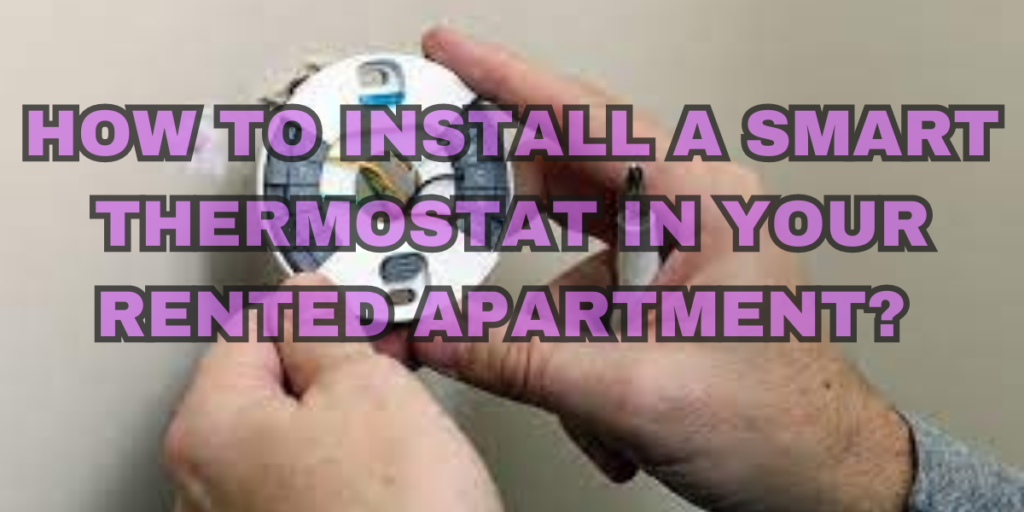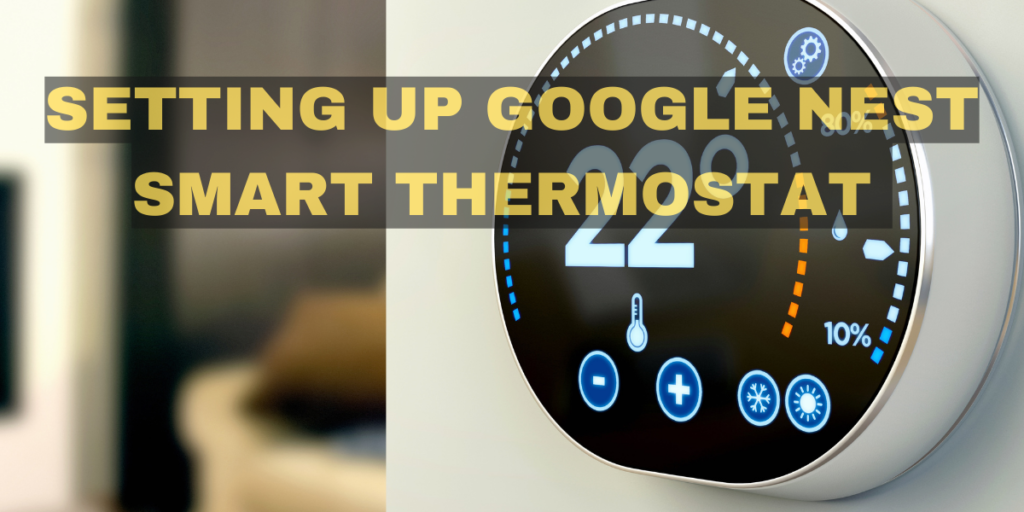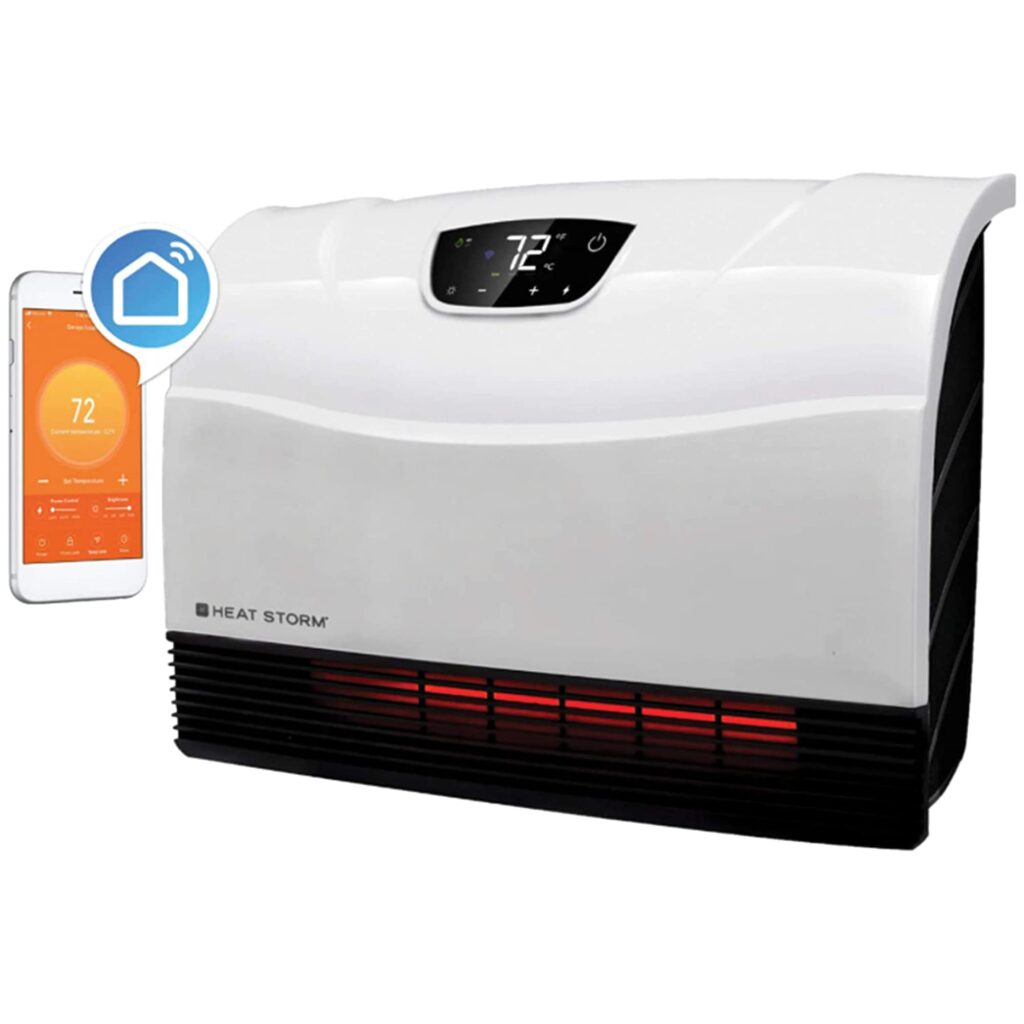Finding a suitable apartment, flat, or condo is already a headache. Shifting to a new place, adjusting it to your needs, and installing a smart thermostat in an apartment with other smart devices can also be an added challenge.

There’s a high possibility you might find an old somewhat functional thermostat in your next rental apartment, fluctuating with electric supply and costing you a few extra bucks in the bill.
Don’t worry, as installing a smart thermostat in an apartment can be your go-to solution to control your indoor temperatures as you want.
If you are planning to move into a new rented place, or have already moved in and are stuck with an old thermostat?
Are you installing a smart thermostat in an apartment for a less costly electricity bill?
Do you think about “Installing a smart thermostat in an apartment and will your landlord let you install one?”
- Is Installing a Smart Thermostat in an Apartment too Hectic?
- What are Smart Thermostats & How to differ from old Thermostats?
- Benefits of Installing a Smart Thermostat
- Why do I need to Upgrade to a Smart Thermostat?
- Finding the Best Thermostat for an Apartment
- Which thermostat is right for you?
- Installing Google Nest Smart Thermostat in an Apartment
- Step 1: Switch off the Power
- Step 2: Removing your Old Thermostat
- Step 3: Using Nest Trim Kit to Install Google Nest Thermostat
- Step 4: Installing the Base Plate & Wiring
- Step 5: Connect to Google Nest Thermostat Display
- Step 6: Turn on the Electric Switch
- Wrapping Up – Final Thoughts
- Frequently Asked Questions
Is Installing a Smart Thermostat in an Apartment too Hectic?
Well, you are renting a place, and certainly, you are eligible to install a smart thermostat in an apartment. However, we advise you first to ask and discuss with your landlord. The latest smart version can also replace the old thermostat.
A smart thermostat can be installed anywhere where a traditional thermostat can be installed. However, the wiring in your apartment may not be compatible with a smart thermostat.
Additionally, your landlord may also not allow you to make changes to your apartment, including installing a smart thermostat. Therefore, checking with your landlord before installing a smart thermostat is important.
Here are some additional things to keep in mind when considering installing a smart thermostat in your apartment:
- Compatibility: Not all smart thermostats are compatible with all heating and cooling systems. Check with your HVAC contractor to make sure the smart thermostat you want to purchase is compatible with your system.
- Electrical Wiring: Some smart thermostats require a C-wire, which is not always present in older homes. If your apartment does not have a C-wire, you may need to hire an electrician to install one.
Check out this guide on how to use a smart plug with a power strip or extension.
- Landlord’s permission: As mentioned above, it is highly recommended to ask your landlord before making any changes to your apartment, including buying and installing a smart thermostat in an apartment.
If you are considering installing a smart thermostat in an apartment, be sure to do your research and check with your landlord first. By doing so, you can ensure that you are able to install a smart thermostat and that it will work properly.
Before you install a nest thermostat in your apartment, the old one needs to be removed first. Make sure to adjust the new smart thermostat into the apartment’s wiring.
The Google Nest Smart Thermostat is one of the most easy to install smart thermostats available in the market but you might still require some prior info about installation and its electrical wiring.
Note: Make sure to check with your landlord’s policy about interfering with the apartment’s electrical wiring.
Your landlord is legally held accountable for the fact that the rented property’s condition is good, and everything is in mint working condition, from electrical wiring to plumbing. Some landlords restrict renters from making any changes or modifications to the apartment’s systems. Do check with your landlord or notify or get permission prior.
Will your Landlord Agree to Install a Smart Thermostat in your Apartment?
You will have to reinstall the old thermostat while moving out. To ensure there will be no deductions in your safety deposit, you need to carefully remove the old one and its wiring in secure packaging so you have no issues in the future.
Once you get an OK from your landlord with all the possible changes and results then there are multiple easy-to-install budget smart thermostats available in the market
What are Smart Thermostats & How to differ from old Thermostats?
We often refer the Smart thermostats as Digital thermostats as they give your complete control over room temperature. With an old thermostat user can control the room temperature via a control pad installed on the apartment wall.
Locate the Control pad and adjust the heating or cooling of the room as per your need. However, with a Smart Thermostat, there are many whistles and bells with useful features and more control over adjusting your room temperature.
You can get data about energy consumption patterns allowing the user to customize room temperatures to save electricity and get reasonable bills. Czech the info below will help you make a smart informed decision before purchasing a smart thermostat.
A positive side of switching from an old to a smart thermostat is that the core function is the same.
Smart Thermostat users go for apps to control and manage them. Also, you can operate via a touch interface on the device like the regular thermostat, it’s helpful if you are a beginner. In case the user loses Wi-Fi connectivity or can’t find a smartphone then you can always regulate the temperature manually with a touch system on the device. Newbies not familiar with the app also use the traditional way to regular room temperature.
Benefits of Installing a Smart Thermostat
Check out the comprehensive Pros and cons of installing a smart thermostat in your apartment.
Pros
- Convenience: Smart thermostats offer multiple settings that can be adjusted from anywhere, so you can always be comfortable, no matter where you are.
- Energy efficiency: When programmed correctly, smart thermostats can help you save energy by learning your habits and adjusting the temperature accordingly.
- Peace of mind: Smart thermostats can take the worry out of heating and cooling your home. They can automatically adjust the temperature when you’re away, so you don’t have to worry about wasting energy.
- Cost savings: Smart thermostats can help you save money on your energy bills by automatically adjusting the temperature when you’re asleep or away.
- Fun: Smart thermostats are fun for tech enthusiasts who like to tinker with new gadgets. They offer a variety of features and settings that can be customized to your liking.
- Improved comfort: Smart thermostats can help you create a more comfortable home environment by automatically adjusting the temperature to your preferences.
- Increased safety: Smart thermostats can help you keep your home safe by automatically turning off the heating and cooling system if there is a power outage.
- Reduced Carbon Footprint: Smart thermostats can help you reduce your carbon footprint by using less energy.
Cons
- Compatibility: Not all smart thermostats are compatible with all heating and cooling systems. It is important to check with your HVAC contractor to make sure the smart thermostat you want to purchase is compatible with your system.
- Installation: Some smart thermostats can be installed by a DIYer, but others may require professional installation. If you are uncomfortable installing a smart thermostat yourself, it is best to hire a professional.
- Cost: The cost of installing a smart thermostat varies depending on the type of thermostat and the labor cost in your area. However, smart thermostats are typically more expensive than traditional thermostats.
- Frequent movers and renters: A smart thermostat may not be your best option if you frequently move or rent. This is because you will need to remove the thermostat when you move, and you may not have permission from your landlord to install a smart thermostat.
Why do I need to Upgrade to a Smart Thermostat?
Traditional thermostats are the most common type of thermostat found in apartments. They are typically less expensive than smart thermostats and can be installed by a DIYer. However, traditional thermostats lack many of the features of smart thermostats, such as geofencing, remote access, and energy-saving programs.
One of the significant factors people forget to consider while asking, “Which thermostat should I go with? is which thermostat will save electricity, lower my electric bill and work efficiently in the Long Run.
A smart thermostat allows the user to be aware of the repetitive pattern to show the heating and cooling frequency required to maintain a controlled and favorable room temperature. It gives the user the ultimate control over maintaining an ideal temperature indoors much more efficiently.
Finding the Best Thermostat for an Apartment
Currently, in the market, you will find a variety of smart thermostats that differ from each other, i.e. having one or two more features and functionality or even a better-upgraded version than the other one. Ensure you buy an easy-to-install but friendly smart thermostat suitable to your requirements.
The Google Nest Learning Thermostat is popular because it is reliable, has many features, and is easy to install.
When choosing a smart thermostat for your apartment, there are several factors to consider:
Easy Installation
Best Appliances are mostly designed to be ergonomic friendly and easy to install. You might need to hire a professional electrician, but we recommend buying smart devices that are easy to maintain, repair and install.
Many Smart Thermostats come with a DIY Installation Kit that requires little to no effort to mount over a wall or plug into an outlet. Such easy-to-install and control smart devices are like long-term investments that save a lot of time, effort, electricity, and money.
Pricing
The cost of a smart thermostat varies on the functionality and features. Consider your budget before just going in and buying the latest smart thermostat with extra functions which you might not even need at your apartment. Go for a mid-range budget smart thermostat that functions well enough to serve like a thermostat.
Programmability
Most buyers want to set the thermostat at once to optimize the room temperature with frequent temperature regulation without human interference.
There are three types of room thermostats depending on the homeowner’s need:
- Smart Thermostats are more convenient with a programmability feature. Users can automate the programmability so the thermostat keeps self-adjusting the temperature. Smart Thermostats can be remotely controlled via the smartphone app.
- Programmable Thermostats are not as expensive as smart thermostats. You can set at different temperatures scheduled at different hours of the day.
- Manual Thermostats are the most affordable ones but they readjust the room temperature manually.
Which thermostat is right for you?
The best thermostat for you depends on your needs and budget. A smart thermostat is a good choice if you’re looking for the most convenient and programmable option. A programmable thermostat is a good option if you’re on a budget. A manual thermostat is a good choice if you don’t need any programmability.
| Thermostat Type | Features | Cost |
| Smart thermostat | Automatic temperature adjustments, remote control, energy-saving features | Most expensive |
| Programmable thermostat | Different temperature settings for different times of day | Less expensive than smart thermostat |
| Manual thermostat | Manual temperature adjustments | Least expensive |
Installing Google Nest Smart Thermostat in an Apartment
Still want to go with a smart thermostat after considering all your options depending on your budget, use, options, and wants?
Well, most Smart Thermostats are compatible with HVAC systems, but still, you need to confirm prior to buying one. Check out the Google Nest compatibility tool to figure out which HVAC system is compatible.

Once your landlord has permitted it, you should first take pictures of the existing electrical wiring of your thermostat as a reference for a compatibility check. Also, you will need these pictures to reset them back when leaving the rental apartment.
Below are given step-by-step instructions on How to install a Nest Thermostat in your apartment.
First, you have to make sure that the current heating and cooling systems are intact and working properly. Check your old thermostat is working in mint condition with no repair issues before removing it. Now, time to remove the old one and install the new and better smart Nest thermostat.
Note: Do not connect thick wires, or 110V, 120V, or 240V wires to your Nest thermostat if your existing thermostat is connected to these wires. Your system is not compatible.
Step 1: Switch off the Power
Use the circuit breaker to switch off the apartment’s heating and cooling system or you can also use the main power switch.
It will be the new thermostat during installation. Legally, tenants have the right to access the circuit breaker at any time. If you are going to deal with the wiring yourself then first make sure to switch off the heating and cooling system.
Step 2: Removing your Old Thermostat
Remove the front of your old thermostat to check the type of system that you have. The Google Nest compatibility tool can help you determine the type of system that you have. Take a picture of the thermostat wiring with your phone so that you can reference it later if you require it. Check whether your thermostat is connected to thick wires labeled with 110V, 120V, or 240V.
If yes, then you have a high-voltage wiring system that might be incompatible with Nest Thermostats. Don’t connect your thermostat, as the wiring is not compatible.
Now once you have upgraded or adjusted to compatible wiring for your Nest Thermostat. Remove the old thermostat gently from the marked wires and reconnect it to the new one.
Step 3: Using Nest Trim Kit to Install Google Nest Thermostat
Did you also buy a Nest Trim Kit with Nest Thermostat?
You will need to install the trim kit before installing the Nest Thermostat. The trim is optional but still useful if removing your old thermostat caused a hole or dent in the paint of the wall.
Go to POPMAS as they have different well-milled solid-colored metal pieces of decorative plates to go with your Nest Thermostat and match your home’s interior.
Step 4: Installing the Base Plate & Wiring
Cross-check if the power is turned off. Now connect the base plate using self-tapping screws and then install the wiring. Make sure the connector button is pushed down once each wire is inserted. Now reconnect each wire according to your HVAC system.
Step 5: Connect to Google Nest Thermostat Display
After connecting the wires, the user will need to connect the display face. While connecting the display with the base, you will hear a clicking sound. Now the thermostat is all set and will function properly.
Step 6: Turn on the Electric Switch
Finally, now activate your circuit breaker or main power switch to test the new Google Nest Thermostat. Your smart thermostat should function properly after installation.
Check out this video guide to help you understand the Google Nest Thermostat installation process.
For more read the guide about Google Nest thermostat star connector.
Wrapping Up – Final Thoughts
Smart thermostats are a great way for tenants to save money, control their home’s climate, and make their homes more secure. Tenants should check with their landlord before installing a smart thermostat and consider a wireless smart thermostat if hardwired installation is not allowed.
Frequently Asked Questions
Other Heating And Cooling Devices Tenants Can Install To Control Optimal Room Temperature are mentioned below:
Crane Infrared Smart Heater
Crane Smart Heater is energy efficient in providing warmth. With the Crane Infrared Smart Heater, users can easily control and manage the heater via the smartphone app.

Crane Smart heater is known to prevent overheating and filter out all allergens and maintain clean air. The heating system is quiet with a minimal appearance, and a child lock system to keep kids and pets safe.
Sensibo Sky – Smart Air Conditioner Controller
The Sensibo Sky Smart Home Air Conditioner System comes with small receiver pods that are connected to your air conditioner to control it via a router-connected hub.

The Sensibo smart home is a portable and affordable device to upgrade your air conditioner with a smart control device. Users can link the device with Alexa or Google Home. Functions Adjusting your temperature, scheduling on-off time, and setting timers make it efficient.
Heat Storm HS-1500-PHX-WiFi Infrared Heater.
The Heat Storm Infrared Heater is a Wi-Fi-enabled heater with excellent heating capacity for one room or limited space.

The Heater is a 1500 Watt device that won’t trip your breaker and quickly heats up the room.
